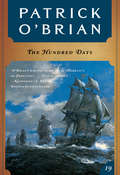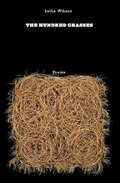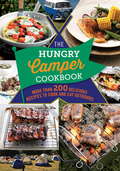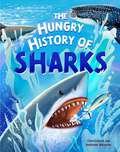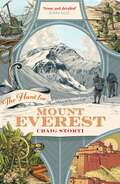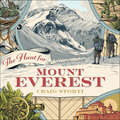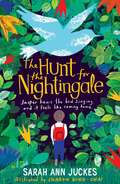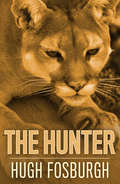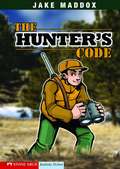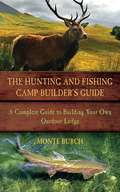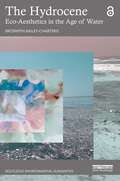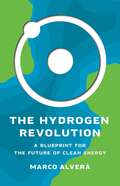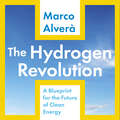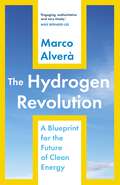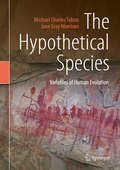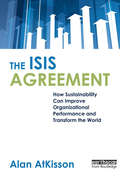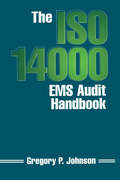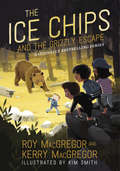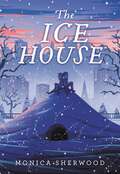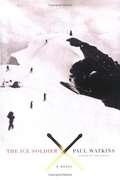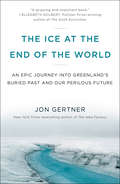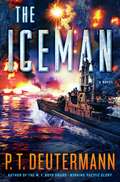- Table View
- List View
The Hundred Days (Vol. Book 19) (Aubrey/Maturin Novels)
by Patrick O'Brian"One of the best novelists since Jane Austen....The Hundred Days may be the best installment yet....I give O'Brian's fans joy of it."--Philadelphia Inquirer Napoleon, escaped from Elba, pursues his enemies across Europe like a vengeful phoenix. If he can corner the British and Prussians before their Russian and Austrian allies arrive, his genius will lead the French armies to triumph at Waterloo. In the Balkans, preparing a thrust northwards into Central Europe to block the Russians and Austrians, a horde of Muslim mercenaries is gathering. They are inclined toward Napoleon because of his conversion to Islam during the Egyptian campaign, but they will not move without a shipment of gold ingots from Sheik Ibn Hazm which, according to British intelligence, is on its way via camel caravan to the coast of North Africa. It is this gold that Jack Aubrey and Stephen Maturin must at all costs intercept. The fate of Europe hinges on their desperate mission.
The Hundred Grasses: Poems
by Leila Wilson&“Beautiful and necessary.&” —DAN BEACHY-QUICKShimmering and formally precise, the poems of this debut collection &“fuse absence and presence in lines full of a feeling that has no opposite&” (Brian Teare).These are poems written from the periphery of an open field, poems rooted in the flatlands and lowlands: the Midwestern lawns, lakes, and creeks of Leila Wilson&’s childhood, and the farms, canals, and seascapes near her family home&’s in Holland. &“We wonder / what we&’re not / in the field,&” writes Wilson—and reading The Hundred Grasses, we too are made to wonder about both what is lacking and what fills the void. In these poems, the act of looking animates what is seemingly static. Stillness becomes not absence but fullness. Sounds are culled from empty spaces, giving shape to life&’s silences. In the process of this hollowing out and filling up, The Hundred Grasses morphs into an extended and unforgettable investigation of longing and loss, love and doubt.
The Hungry Camper Cookbook: More than 200 delicious recipes to cook and eat outdoors (The Hungry Cookbooks)
by SpruceA camping cookbook like no other, The Hungry Camper not only gives more than 200 quick, cheap and delicious recipes that all the family will love, but also includes helpful checklists on what to bring along, how to prepare for big family meals, and invaluable camping tips for a stress-free trip. With chapters dedicated to making sure you have a hearty breakfast, making the most of a campfire with barbecue dishes, one pot simplicity and a host of salads, sides and snacks aplenty, camping food never has to be boring again.Including recipes from treacle and mustard beans, grilled sardines with salsa and goulash with caraway dumplings, to coconut dahl, hot barbecued fruit salad and creole pineapple wedges, each recipe is easy to make in a campsite for even the most novice cook, tired from a day's adventure.
The Hungry History of Sharks (History of... #1)
by Clive GiffordThink all sharks are man-eating terrors? Think again! There's so much more to these fascinating and frequently misunderstood animals. This book takes you through the hungry history of these incredible creatures.Sharks range in size from whale sharks longer than buses, to Panama catsharks and dwarf lantern sharks that could sit across the palm of your hand. Find out about baby sharks, prehistoric sharks, the largest known shark - the Megaladon, bull sharks, reef sharks and angel sharks, amongst others. Look inside at the parts of a shark, such as their very light skeleton, their razor-sharp teeth and their extra special electric sense that humans don't have. Learn about their clever hunting and feeding techniques.How do we know so much about sharks? Discover how scientists are using many different technologies to find, follow and examine sharks to learn more about them. More than one-third of all shark and ray species are in danger of extinction. Learn what people are doing to help these formidable creatures.The colourful and detailed illustrations from Andressa Meissner bring the sharks vividly to life. The consultant, Leonardo Guida, (PhD) is a shark scientist and shark conservation lead at the Australian Marine Conservation Society.
The Hunt (Hunt Trilogy #1)
by Andrew FukudaDon't Sweat. Don't Laugh. Don't draw attention to yourself. And most of all, whatever you do, do not fall in love with one of them. Gene is different from everyone else around him. He can't run with lightning speed, sunlight doesn't hurt him and he doesn't have an unquenchable lust for blood. Gene is a human, and he knows the rules. Keep the truth a secret. It's the only way to stay alive in a world of night―a world where humans are considered a delicacy and hunted for their blood. When he's chosen for a once in a lifetime opportunity to hunt the last remaining humans, Gene's carefully constructed life begins to crumble around him. He's thrust into the path of a girl who makes him feel things he never thought possible―and into a ruthless pack of hunters whose suspicions about his true nature are growing. Now that Gene has finally found something worth fighting for, his need to survive is stronger than ever―but is it worth the cost of his humanity?
The Hunt for Mount Everest
by Craig StortiThe height of Mt. Everest was first measured in 1850, but the closest any westerner got to Everest during the next 71 years, until 1921, was 40 miles. The Hunt for Mt. Everest tells the story of the 71-year quest to find the world's highest mountain. It's a tale of high drama, of larger-than-life characters-George Everest, Francis Younghusband, George Mallory, Lord Curzon, Edward Whymper-and a few quiet heroes: Alexander Kellas, the 13th Dalai Lama, Charles Bell. A story that traverses the Alps, the Himalayas, Nepal and Tibet, the British Empire (especially British India and the Raj), the Anglo-Russian rivalry known as The Great Game, the disastrous First Afghan War, and the phenomenal Survey of India - it is far bigger than simply the tallest mountain in the world. Encountering spies, war, political intrigues, and hundreds of mules, camels, bullocks, yaks, and two zebrules, Craig Storti uncovers the fascinating and still largely overlooked saga of all that led up to that moment in late June of 1921 when two English climbers, George Mallory and Guy Bullock, became the first westerners-and almost certainly the first human beings-to set foot on Mt. Everest and thereby claimed the last remaining major prize in the history of exploration.With 2021 bringing the 100th anniversary of that year, most Everest chronicles have dealt with the climbing history of the mountain, with all that happened after 1921. The Hunt for Mt. Everest is the seldom-told story of all that happened before.
The Hunt for Mount Everest
by Craig StortiThe height of Mt. Everest was first measured in 1850, but the closest any westerner got to Everest during the next 71 years, until 1921, was 40 miles. The Hunt for Mt. Everest tells the story of the 71-year quest to find the world's highest mountain. It's a tale of high drama, of larger-than-life characters-George Everest, Francis Younghusband, George Mallory, Lord Curzon, Edward Whymper-and a few quiet heroes: Alexander Kellas, the 13th Dalai Lama, Charles Bell. A story that traverses the Alps, the Himalayas, Nepal and Tibet, the British Empire (especially British India and the Raj), the Anglo-Russian rivalry known as The Great Game, the disastrous First Afghan War, and the phenomenal Survey of India - it is far bigger than simply the tallest mountain in the world. Encountering spies, war, political intrigues, and hundreds of mules, camels, bullocks, yaks, and two zebrules, Craig Storti uncovers the fascinating and still largely overlooked saga of all that led up to that moment in late June of 1921 when two English climbers, George Mallory and Guy Bullock, became the first westerners-and almost certainly the first human beings-to set foot on Mt. Everest and thereby claimed the last remaining major prize in the history of exploration.With 2021 bringing the 100th anniversary of that year, most Everest chronicles have dealt with the climbing history of the mountain, with all that happened after 1921. The Hunt for Mt. Everest is the seldom-told story of all that happened before.(P) 2020 Hodder & Stoughton Ltd
The Hunt for the Nightingale
by Sarah Ann JuckesDiscover the healing power of nature in one boy's heartbreaking and hopeful journey back from the wilderness.Bird fact no. 30: a nightingale song is one of the most beautiful sounds on the planet. Ten-year-old Jasper has been waiting all spring for his beloved nightingale to return to his garden and sing. But it's not there, and neither is his sister, Rosie. His parents seem sad and preoccupied, so gathering his courage, his backpack and his treasured Book of Birds, Jasper sets out alone on a walk to find them both. The expedition takes Jasper through town and country, meeting a host of characters who are also searching for lost things. Helping his new friends, Jasper begins to see that he may not find what he is looking for when he reaches the journey's end, but even in the darkest of moments, a nightingale's song can be heard somewhere. A love letter to the natural world, Sarah Ann Juckes' stunning middle grade novel, illustrated by the award-winning Sharon King-Chai will have you turning the last page with tears in your eyes and a heart full of hope. For fans of Pax, Wonder and Wild Child.
The Hunter
by Hugh FosburghThe Hunter, first published in 1950, is a lean novel in the Hemingway tradition that captures the essence of the big-game hunt. Set in the southern Rocky Mountains, the book focuses on Monk Taylor, living in semi-isolation with Billy Trott, a native, and a half-crazed old woman, only lives to track big-game while avoiding obligations to others, including the woman, Marge, who loves him. Monk agrees to guide two easterners on a lion hunt, but in a fit of rudeness, Monk ends the hunt but is soon himself lying injured and horseless in a gully. Saved, and brought back to Marge by Billy Trott, Monk fantasizes about marriage, but when he realizes he has nothing to give her or anyone else, he once again sends her away.
The Hunter's Code
by Jake MaddoxEthan knows that killing animals for fun is against the Hunter's Code. Or does he?
The Hunting and Fishing Camp Builder's Guide: A Complete Guide to Building Your Own Outdoor Lodge
by Monte BurchThere cannot be a hunter and angler who has not, at some time or other, daydreamed about building his or her own camp. Hunting & Fishing Camp Builder's Guide provides the concepts, plans, and know-how to turn a daydream into a reality. Monte Burch applies decades of how-to skills to describe the "ins and outs" of design and construction. From the cabin to the furniture inside, you can do it all yourself and create the camp or lodge of your dreams.
The Husky: The Kekeko International Sled Dog Race
by Yves Patrick BeaulieuThe capital of Abitibi, Rouyn-Noranda, is hosting the International Kekeko this winter, the great sled dog race. That day, Rodolphe Galarneau, a newcomer to this universe, did not suspect for a moment that he would finish on the Podium.
The Hydrocene: Eco-Aesthetics in the Age of Water (ISSN)
by Bronwyn Bailey-CharterisThis book challenges conventional notions of the Anthropocene and champions the Hydrocene: the Age of Water. It presents the Hydrocene as a disruptive, conceptual epoch and curatorial theory, emphasising water's pivotal role in the climate crisis and contemporary art.The Hydrocene is a wet ontological shift in eco-aesthetics which redefines our approach to water, transcending anthropocentric, neo-colonial and environmentally destructive ways of relating to water. As the most fundamental of elements, water has become increasingly politicised, threatened and challenged by the climate crisis. In response, The Hydrocene articulates and embodies the distinctive ways contemporary artists relate and engage with water, offering valuable lessons towards climate action. Through five compelling case studies across swamp, river, ocean, fog and ice, this book binds feminist environmental humanities theories with the practices of eco-visionary artists. Focusing on Nordic and Oceanic water-based artworks, it demonstrates how art can disrupt established human–water dynamics. By engaging hydrofeminist, care-based and planetary thinking, The Hydrocene learns from the knowledge and agency of water itself within the tide of art going into the blue.The Hydrocene urgently highlights the transformative power of eco-visionary artists in reshaping human–water relations. At the confluence of contemporary art, curatorial theory, climate concerns and environmental humanities, this book is essential reading for researchers, curators, artists, students and those seeking to reconsider their connection with water and advocate for climate justice amid the ongoing natural-cultural water crisis.The Open Access version of this book, available at http://www.taylorfrancis.com, has been made available under a Creative Commons Attribution-Non Commercial-No Derivatives (CC-BY-NC-ND) 4.0 license.
The Hydrogen Revolution: A Blueprint for the Future of Clean Energy
by Marco AlveràAn energy expert shows why hydrogen can fight climate change and become the fuel of the future We&’re constantly told that our planet is in crisis; that to save it, we must stop traveling, stop eating meat, even stop having children. But in The Hydrogen Revolution, Marco Alverà argues that we don&’t need to upend our lives. We just need a new kind of fuel: hydrogen. From transportation and infrastructure to heating and electricity, hydrogen could eliminate fossil fuels, boost economic growth, and encourage global action on climate change. It could also solve the most bedeviling aspects of today&’s renewable energy—from transporting and storing wind and solar energy and their vulnerability to weather changes to the inefficiency and limited utility of heavy, short-lasting batteries. The Hydrogen Revolution isn&’t just a manifesto for a powerful new technology. It&’s a hopeful reminder that despite the gloomy headlines about the fate of our planet, there&’s still an opportunity to turn things around.
The Hydrogen Revolution: a blueprint for the future of clean energy
by Marco Alverà'Engaging, authoritative and very timely. Marco Alverà spells Hydrogen's critical role as an energy store in the clean power transition' - Mike Berners-Lee, author of THERE IS NO PLANET BPicture this: It's 2050. The looming shadow of climate change is finally receding. The planet's temperature is stabilising. Rainforests and coral reefs beginning to thrive once more. We are returning to equilibrium with nature. This isn't wishful thinking; it can be our reality. We just need to embrace hydrogen: the missing link.The beauty of hydrogen is its simplicity. It's simple to make, and simple to use. You are essentially bottling sunlight from renewable energy sources in the form of hydrogen, and using it to bring clean energy to every corner of the globe. The best part about hydrogen is that when you use it, the only by-product is water.As energy expert Marco Alverà explains, if we're going to heal the climate, we need to start thinking big. This book is the blueprint for how to get us there. Whether you are a policy maker, a business person, an activist, or simply curious, the message is this: there is hope, for us and our planet. Hydrogen can help save the world.(P) 2021 Hodder & Stoughton Limited
The Hydrogen Revolution: a blueprint for the future of clean energy
by Marco Alverà'Engaging, authoritative and very timely. Marco Alverà spells Hydrogen's critical role as an energy store in the clean power transition' - Mike Berners-Lee, author of THERE IS NO PLANET BPicture this: It's 2050. The looming shadow of climate change is finally receding. The planet's temperature is stabilising. Rainforests and coral reefs beginning to thrive once more. We are returning to equilibrium with nature. This isn't wishful thinking; it can be our reality. We just need to embrace hydrogen: the missing link.The beauty of hydrogen is its simplicity. It's simple to make, and simple to use. You are essentially bottling sunlight from renewable energy sources in the form of hydrogen, and using it to bring clean energy to every corner of the globe. The best part about hydrogen is that when you use it, the only by-product is water.As energy expert Marco Alverà explains, if we're going to heal the climate, we need to start thinking big. This book is the blueprint for how to get us there. Whether you are a policy maker, a business person, an activist, or simply curious, the message is this: there is hope, for us and our planet. Hydrogen can help save the world.
The Hyena Scientist (Scientists in the Field Series)
by Sy Montgomery Nic BishopThis myth-busting new addition to the critically acclaimed Scientists in the Field series by Sibert medal winning team Sy Montgomery and Nic Bishop is perfect for nonfiction readers looking for more female scientist narratives, or a fresh perspective on an underrepresented animal—Hyenas! Timely and inspiring, The Hyena Scientist sets the record straight about one of history’s most hated and misunderstood mammals, while featuring the groundbreaking, pioneering research of a female scientist in a predominately male field in this offering by Sibert-winning duo Sy Montgomery and Nic Bishop. As a scientist studying one of the only mammalian societies led entirely by females, zoologist Kay Holecamp has made it her life’s work to understand hyenas, the fascinating, complex creatures that are playful, social, and highly intelligent—almost nothing like the mangy monsters of pop culture lore.
The Hypothetical Species: Variables of Human Evolution
by Michael Charles Tobias Jane Gray MorrisonThis book is a provocative and invigorating real-time exploration of the future of human evolution by two of the world’s leading interdisciplinary ecologists – Michael Charles Tobias and Jane Gray Morrison. Steeped in a rich multitude of the sciences and humanities, the book enshrines an elegant narrative that is highly empathetic, personal, scientifically wide-ranging and original. It focuses on the geo-positioning of the human Self and its corresponding species. The book's overarching viewpoints and poignant through-story examine and powerfully challenge concepts associated historically with assertions of human superiority over all other life forms. Ultimately, The Hypothetical Species: Variables of Human Evolution is a deeply considered treatise on the ecological and psychological state of humanity and her options – both within, and outside the rubrics of evolutionary research – for survival. This important work is beautifully presented with nearly 200 diverse illustrations, and is introduced with a foreword by famed paleobiologist, Dr. Melanie DeVore.
The ISIS Agreement: How Sustainability Can Improve Organizational Performance and Transform the World
by Alan AtKissonThis is the must-have book for leaders in business, organizations and government who are scrambling to get a grip on sustainability while improving performance in the era of climate change. Renowned business and sustainability consultant Alan AtKisson distils decades of wisdom and experience into this highly readable and motivational work. Covering theory and practice, obstacles and opportunities, case studies and poignant personal anecdotes, The ISIS Agreement draws the reader ever deeper into a global 'conspiracy of hope.' The core of the book is AtKisson's potent Accelerator, adopted for use in dozens of countries by business, governments, and organizations such as UNEP. A comprehensive toolkit that helps integrate sustainability into organizations, initiatives and plans, it can be used by any group, organization, business, community or region, in virtually any context. Central to the Accelerator is the potent ISIS (Indicators, Systems, Innovation, Strategy) method that teaches leaders how to create a whole-systems view of their organization, to identify and understand blockages and opportunities, and to leverage the potential for innovative change that adds value and accelerates progress towards sustainability.
The ISO 14000 EMS Audit Handbook
by Greg JohnsonThe ISO 14000 EMS Audit Handbook is an innovative and cost-effective approach for the Environmental Management System (EMS) audit to ISO 14001. The Handbook presents comprehensive strategies for conducting all phases of the EMS audit, including effective assessment processes for determining improved environmental performance.
The Ice Chips and the Grizzly Escape (Ice Chips)
by Roy MacGregor Kerry MacGregorThe fifth title in the beloved and bestselling Ice Chips series by acclaimed authors Roy MacGregor and Kerry MacGregor and illustrator Kim Smith, featuring a vibrant and diverse cast of characters and inspiring hockey greats In their latest adventure, the Chips travel to British Columbia, meet an inspiring young hockey hero and escape up Anahim Peak, thanks to their new friend’s calm head—and a very special puck!
The Ice House
by Monica SherwoodWith shades of When You Reach Me, The Thing About Jellyfish, and Bridge to Terabithia, and a big, timely climate hook at its core, here is a heartfelt middle grade debut about the inevitability of change that will resonate profoundly during these extraordinary times.Spring has arrived, and yet an unyielding winter freeze has left Louisa snowed into her apartment building for months with parents coping with extreme stress, a little brother struggling with cabin fever, and—awkwardly—her neighbor and former close friend, Luke. The new realities of this climate disaster have not only affected Louisa's family, but when Luke's dad has an ice-related accident and it's unclear if he'll recover, both families' lives are turned upside down.Desperate to find an escape from the grief plaguing their homes, Louisa and Luke build a massive snow fort in their yard. But their creation opens up an otherworldly window to what could lie ahead, and sets them on a mission: to restore the universe to its rightful order, so the ice will melt and life will return to "normal".With a deft combination of heartfelt prose and a touch of magic, Monica Sherwood's affecting debut novel is a relatable story of families grappling with—and emerging from—a different kind of quarantine.
The Ice Soldier
by Paul WatkinsFrom the book jacket: The year is 1950 and Captain William Bromley, formerly one of the world's greatest mountaineers, has retired into obscurity. Having barely survived the infamous Palladino Road, high in the Italian Alps during WWII, Bromley has sworn he'll never climb again. It is only when a soldier from Bromley's old mountain regiment appears that his peaceful world begins to crumble. A terrifying request is made, and for reasons that have haunted Bromley since the battle at Palladino, he knows he cannot refuse. Bromley must now return to those same mountains that almost cost him his life, in order not only to confront the demons of his past, but to repay the debt that saved him years before. The little-known role of the army's mountaineer corps comes brilliantly to life in this story of a man pushed to the limits of endurance and survival, and haunted by the ghosts of war.
The Ice at the End of the World: An Epic Journey into Greenland's Buried Past and Our Perilous Future
by Jon GertnerA riveting, urgent account of the explorers and scientists racing to understand the rapidly melting ice sheet in Greenland, a dramatic harbinger of climate change“Jon Gertner takes readers to spots few journalists or even explorers have visited. The result is a gripping and important book.”—Elizabeth Kolbert, Pulitzer Prize–winning author of The Sixth Extinction Greenland: a remote, mysterious island five times the size of California but with a population of just 56,000. The ice sheet that covers it is 700 miles wide and 1,500 miles long, and is composed of nearly three quadrillion tons of ice. For the last 150 years, explorers and scientists have sought to understand Greenland—at first hoping that it would serve as a gateway to the North Pole, and later coming to realize that it contained essential information about our climate. Locked within this vast and frozen white desert are some of the most profound secrets about our planet and its future. Greenland’s ice doesn’t just tell us where we’ve been. More urgently, it tells us where we’re headed. In The Ice at the End of the World, Jon Gertner explains how Greenland has evolved from one of earth’s last frontiers to its largest scientific laboratory. The history of Greenland’s ice begins with the explorers who arrived here at the turn of the twentieth century—first on foot, then on skis, then on crude, motorized sleds—and embarked on grueling expeditions that took as long as a year and often ended in frostbitten tragedy. Their original goal was simple: to conquer Greenland’s seemingly infinite interior. Yet their efforts eventually gave way to scientists who built lonely encampments out on the ice and began drilling—one mile, two miles down. Their aim was to pull up ice cores that could reveal the deepest mysteries of earth’s past, going back hundreds of thousands of years. Today, scientists from all over the world are deploying every technological tool available to uncover the secrets of this frozen island before it’s too late. As Greenland’s ice melts and runs off into the sea, it not only threatens to affect hundreds of millions of people who live in coastal areas. It will also have drastic effects on ocean currents, weather systems, economies, and migration patterns. Gertner chronicles the unfathomable hardships, amazing discoveries, and scientific achievements of the Arctic’s explorers and researchers with a transporting, deeply intelligent style—and a keen sense of what this work means for the rest of us. The melting ice sheet in Greenland is, in a way, an analog for time. It contains the past. It reflects the present. It can also tell us how much time we might have left.
The Iceman: A Novel
by P. T. DeutermannThe Iceman is an action-packed World War II military thriller featuring a daring United States Navy submarine commander during the Pacific war in 1942-43.In 1942, off the port city of St. Nazaire in occupied France, a United States Navy S-class submarine assigned to the Royal Navy lurks just outside the borders of the minefield protecting a German U-boat base. Lieutenant Commander Malachi Stormes, the boat’s skipper, patrols dangerously close to the minefield entrance and manages to trap and sink three outbound U-boats in one spectacular attack. Britain decorates him, the U.S. Navy promotes him and then gives him command of a brand new class of submarine, a fleet boat called Firefish. Based in Perth, Australia, having been driven out of the Philippines by the Japanese juggernaut, the Perth boats are the only American forces capable of hitting the Japanese in the western Pacific.Stormes, with his cold, steely-eyed focus on killing Japanese ships, is an enigma to his officers and crew, especially when it becomes clear that he is willing to take huge chances to achieve results. Firefish sinks more ships than any Perth boat on her first war patrol, but Stormes’ unconventional tactics literally frighten his crew. Driven by a past steeped in the whiskey-haunted violence of the Kentucky coal fields, whose psychological scars torment his sleep and close him off from personal relationships, Stormes is nicknamed The Iceman. His crew is proud of their boat’s accomplishments, but wonder if their iron-willed skipper will bring them home alive.With intense action and featuring authentic submarine tactics in the early years of the Pacific war, The Iceman continues P. T. Deutermann's masterful, award-winning cycle of thrillers set during World War II.
